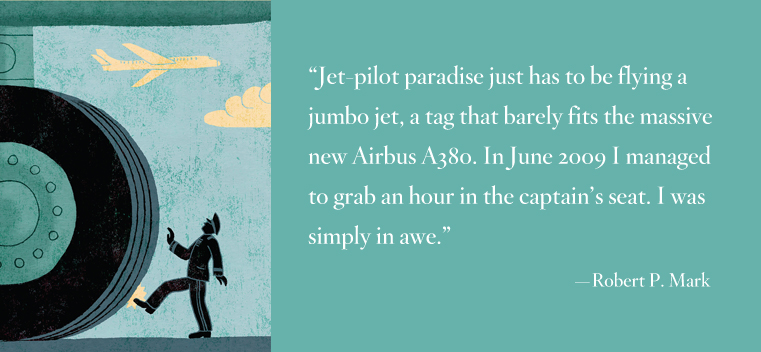
Flying the Big Bird
Robert P. Mark (GJ95) is a commercial pilot, award-winning journalist and an adjunct lecturer at the Medill School of Journalism, Media, Integrated Marketing Communications.
Tell us what you think. E-mail comments or questions to the editors at letters@northwestern.edu.
We’re always on the lookout for fresh alumni insights. If you’d like to submit a Purple Prose essay, read our guidelines.
Find Us on Social Media
Veteran pilot gets jazzed on test drive.
When I was a young pup of a commercial pilot, I so wanted to captain one of those big jets that passed by my beat-up old freight-hauling bird. A jet pilot’s life would be so easy, I thought. Just flip a few switches, wait for those big engines to roar to life and blast off into the blue sky, headed toward some exotic location.
But, as often happens, reality quashed my dream as one airline after another I flew for shut down, or some company would dump its private airplane and me along with it. Eventually I figured out a way to blend the life of an aviator with that of a writer — my other dream career — jumping at the opportunity to pen some Motor Trend–like aircraft reviews for Aviation International News.
Since pilots all know that bigger jets are better, jet-pilot paradise just has to be flying a jumbo jet, a tag that barely fits the massive new Airbus A380. In June 2009 I managed to grab an hour in the captain’s seat of an early-production A380 at Airbus’ Toulouse, France, factory when AIN asked me to evaluate the jet’s new computerized braking system.
I was simply in awe as I walked around beneath the 238-foot A380 with its 262-foot wingspan and a cockpit that sits nearly 30 feet above the ground. Maybe it was the pilot ritual of kicking all 22 tires, checking for flats, that increased the wow factor before I climbed aboard. But then again, maybe it was watching the ground trucks add enough jet fuel — about 85,000 gallons — to carry the aircraft 9,500 miles between fill-ups. Inside, the cabin is vast enough to squeeze in as many as 853 passengers, while the central forward staircase is wide enough that three people can walk abreast simultaneously and never rub elbows.
The Airbus is so quiet at start-up that if you weren’t watching the cockpit displays, you’d be blissfully unaware that the Rolls Royce engines were even turning.
With the cockpit sitting a very, very long way ahead of and above the engines, my shoving the throttles halfway up on takeoff seemed, at first, to create no reaction — no noise or even any vibration. Next I did what any pilot would do: I pushed the throttles right to the firewall, much to the eventual discomfort of those big motors, as well as my instructor, who seemed ready to cry. It’s all about the physics of moving from zero pounds of thrust to nearly 300,000 pounds; it takes a couple of seconds before the pilot notices anything, especially if you want the engines to last.
Another really strange sensation occurred as we were rolling down the runway on takeoff. When I was expected to pull back on the stick and raise the nose for liftoff, the optical illusion effect of that height gave me the feeling we were moving too slowly to fly. My co-pilot reminded me again, so I eased the digital side-stick back, and the A380 leaped into the gray French afternoon.
My co-pilot announced “positive climb rate,” the standard call, which meant it was safe to raise the landing gear. I still have no idea how long it took to raise the landing gear on the first takeoff, because I was so amazed at the lightness of the aircraft. We weighed about 900,000 pounds on this particular flight, but the Airbus flew like a zippy little single-engine Cirrus. As we climbed to traffic-pattern altitude, about 2,000 feet above the ground, I tried some 45-degree steep turns. The aircraft responded effortlessly. The computer senses everything and compensates automatically for any pressures the pilot would normally add to the stick.
The landings were planned to demonstrate the new Airbus Brake to Vacate System that minimizes aircraft time on the runway after landing and pinpoints exactly where the aircraft can turn off on a taxiway. Besides wasting time, missing a taxiway after landing means another aircraft on final approach will probably need to go around and try again, which reduces airport acceptance rates and wastes fuel.
The A380’s computers already know the aircraft’s landing weight and, when runway conditions are added in, can determine at which intersection the aircraft will halt to clear the runway. On touchdown, the flying pilot never touches the rudder or brake pedals; the A380’s autobrakes do all the work.
After I turned off the runway and began the taxi back to the hangar, I realized I’d not just made the big time but the really, really big time. Just in case though, a friend shot a photo of me in the left seat of the cockpit to quell the eventual rumors that my flight just might have been one of those really big tall tales pilots are sometimes prone to tell.



 Facebook
Facebook Twitter
Twitter Email
Email


